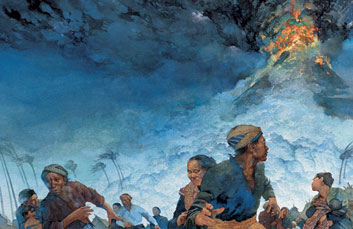Heavy eruptions of the Tambora volcano in Indonesia are letting up by this day in 1815. The volcano, which began rumbling on April 5, killed almost 100,000 people directly and indirectly. The eruption was the largest ever recorded and its effects were noted throughout the world.
Tambora is located on Sumbawa Island, on the eastern end of the Indonesian archipelago. There had been no signs of volcanic activity there for thousands of years prior to the 1815 eruption. On April 10, the first of a series of eruptions that month sent ash 20 miles into the atmosphere, covering the island with ash to a height of 1.5 meters.

 Five days later, Tambora erupted violently once again. This time, so much ash was expelled that the sun was not seen for several days. Flaming hot debris thrown into the surrounding ocean caused explosions of steam. The debris also caused a moderate-sized tsunami. In all, so much rock and ash was thrown out of Tambora that the height of the volcano was reduced from 14,000 to 9,000 feet.
Five days later, Tambora erupted violently once again. This time, so much ash was expelled that the sun was not seen for several days. Flaming hot debris thrown into the surrounding ocean caused explosions of steam. The debris also caused a moderate-sized tsunami. In all, so much rock and ash was thrown out of Tambora that the height of the volcano was reduced from 14,000 to 9,000 feet. The worst explosions were heard hundreds of miles away. The eruptions of Tambora also affected the climate worldwide. Enough ash had been thrown into the atmosphere that global temperatures were reduced over the next year; it also caused spectacularly colored sunsets throughout the world. The eruption was blamed for snow and frost in New England during June and July that summer.
Ten thousand people were killed by the eruptions, most on Sumbawa Island. In subsequent months, more than 80,000 people died in the surrounding area from starvation due to the resulting crop failures and disease.

Taken from: http://www.history.com/this-day-in-history/volcanic-eruption-kills-80000 [17.04.12]


No comments:
Post a Comment